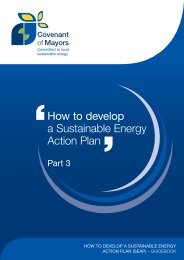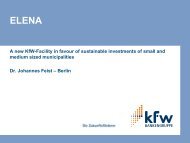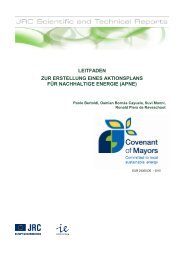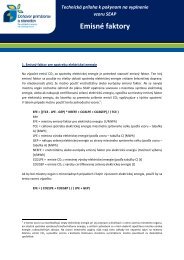English - Covenant of Mayors
English - Covenant of Mayors
English - Covenant of Mayors
Create successful ePaper yourself
Turn your PDF publications into a flip-book with our unique Google optimized e-Paper software.
If a part <strong>of</strong> the heat/cold that is produced in the territory<br />
<strong>of</strong> the local authority is exported, then the corresponding<br />
share <strong>of</strong> CO 2<br />
emissions should be deducted when<br />
calculating the emission factor for heat/cold production<br />
(EFH), as indicated in the formula below. In a similar<br />
manner, if heat/cold is imported from a plant situated<br />
outside the local authority, then the share <strong>of</strong> CO 2<br />
emissions<br />
<strong>of</strong> this plant that correspond to heat/cold consumed in the<br />
territory <strong>of</strong> the local authority should be accounted for<br />
when calculating the emission factor (see formula below).<br />
The following formula may be applied to calculate the<br />
emission factor for heat, taking the above mentioned<br />
issues into consideration.<br />
EFH = (CO2LPH + CO2IH – CO2EH) / LHC<br />
Where<br />
EFH = emission factor for heat [t/MWh heat<br />
]<br />
CO2LPH = CO 2<br />
emissions due to the local production<br />
<strong>of</strong> heat (as per table D <strong>of</strong> the template) [t]<br />
CO2IH = CO 2<br />
emissions related to any imported<br />
heat from outside the territory <strong>of</strong> the local<br />
authority [t]<br />
CO2EH = CO 2<br />
emissions related to any heat that is<br />
exported outside <strong>of</strong> the territory <strong>of</strong> the local<br />
authority [t]<br />
LHC = local heat consumption (as per table A)<br />
[MWh heat<br />
]<br />
A similar formula may apply for cold.<br />
District cooling, i.e. purchased chilled water, is in principle<br />
a similar product as purchased district heating. However,<br />
the process to produce district cooling is different from<br />
the process to produce district heating, and there is<br />
a larger variety <strong>of</strong> production methods.<br />
If local production <strong>of</strong> district cooling occurs, or if district<br />
cooling is consumed as a commodity by end-users, the<br />
local authority is recommended to contact the district<br />
cooling provider for information on the use <strong>of</strong> fuels or<br />
electricity to provide cooling. Then the emission factors<br />
for fuels and electricity presented in the Sections above<br />
can be applied.<br />
3.5.1 Combined heat and power production (CHP)<br />
Part or all <strong>of</strong> the heat used in the territory <strong>of</strong> the local<br />
authority may be generated in a combined heat and power<br />
(CHP) plant. It is essential to divide the emissions <strong>of</strong> a CHP<br />
plant between heat and electricity when filling Tables C<br />
and D <strong>of</strong> the template. This is especially the case when<br />
the heat is used locally (input to the BEI), but the electricity<br />
is sold to the regional grid (no direct input to BEI).<br />
The fuel use and emissions can be allocated between heat<br />
and electricity generation by using the following Equation:<br />
CO2 CHPH<br />
=<br />
CO2 CHPE<br />
= CO2 CHPT<br />
– CO2 CHPH<br />
Where<br />
CO2 CHPH<br />
denotes CO 2<br />
emissions from heat production [t<br />
CO 2<br />
]<br />
CO2 CHPE<br />
denotes CO 2<br />
emissions from electricity<br />
production [t CO 2<br />
]<br />
CO2 CHPT<br />
denotes total CO 2<br />
emissions <strong>of</strong> the CHP plant<br />
calculated based on fuel consumption and fuel-specific<br />
emission factors [t CO 2<br />
]<br />
P CHPH<br />
denotes the amount <strong>of</strong> heat produced [MWh heat<br />
]<br />
P CHPE<br />
denotes the amount <strong>of</strong> electricity produced [MWh e<br />
]<br />
h<br />
denotes the typical efficiency <strong>of</strong> separate heat<br />
production. The recommended value to be used is 90 %.<br />
e<br />
denotes the typical efficiency <strong>of</strong> separate electricity<br />
production. The recommended value to be used is 40 %.<br />
3.6 Other sectors<br />
P CHPH<br />
h<br />
P CHPH<br />
P CHPE<br />
+<br />
h<br />
e<br />
* CO2 CHPT<br />
In the case <strong>of</strong> other sectors, the emissions <strong>of</strong> which are<br />
not related to fuel combustion, the local authority is<br />
recommended to use methodologies developed by<br />
specialised organisations.<br />
If the local authority has chosen to use the standard<br />
emission factors in line with IPCC principles, it may<br />
consider using the methodologies <strong>of</strong> Local Governments<br />
for Sustainability (ICLEI) and Intergovernmental Panel on<br />
Climate Change (IPCC).<br />
The ICLEI’s International Local Government GHG<br />
Emissions Analysis Protocol (IEAP) also includes peer<br />
reviewed and approved Specific Country Supplements for<br />
certain countries, with country-specific emission factors.<br />
Supplements for Italy, Spain and Poland are currently<br />
under development. The activity will be extended to other<br />
European countries as resources become available.<br />
1. The IEAP and country supplements are available at<br />
www.iclei.org/ghgprotocol<br />
2. The 2006 IPCC Guidelines are available at<br />
http://www.ipcc-nggip.iges.or.jp/public/2006gl/index.html<br />
3. If the local authority has chosen to use the LCA emission<br />
factors, such emission factors for landfills are available from<br />
the ELCD database:<br />
http://lca.jrc.ec.europa.eu/lcainfohub/datasetList.<br />
vm?topCategory=End-<strong>of</strong>-life+treatment&subCategory=<br />
Landfilling<br />
17












